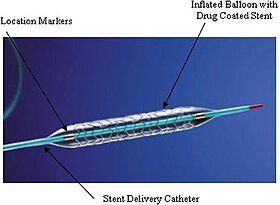| Coronary stent | |
|---|---|
 An example of a coronary stent. This Taxus stent is labeled as a drug-eluting stent. | |
| ICD-9-CM | 36.06 |
A coronary stent is a tube-shaped device placed in the coronary arteries that supply blood to the heart, to keep the arteries open in patients suffering from coronary heart disease. The vast majority of stents used in modern interventional cardiology are drug-eluting stents (DES). They are used in a medical procedure called percutaneous coronary intervention (PCI). Coronary stents are divided into two broad types: drug-eluting and bare metal stents. As of 2023, drug-eluting stents were used in more than 90% of all PCI procedures.[1][2] Stents reduce angina (chest pain) and have been shown to improve survival and decrease adverse events after a patient has suffered a heart attack—medically termed an acute myocardial infarction.[3][4]
Similar stents and stenting procedures are used in atherosclerosis of arterial vessels of the limbs—particularly in the legs, such as in peripheral artery disease.[5]
- ^ Zipes DP, Libby P, Bonow RO, Mann DL, Tomaselli GF, Braunwald E (2018-01-09). Braunwald's heart disease : a textbook of cardiovascular medicine (Eleventh ed.). Philadelphia, PA: Elsevier/Saunders. ISBN 9780323555937. OCLC 1021152059.
- ^ Koźlik, Maciej; Harpula, Jan; Chuchra, Piotr J.; Nowak, Magdalena; Wojakowski, Wojciech; Gąsior, Paweł (2023-02-09). "Drug-Eluting Stents: Technical and Clinical Progress". Biomimetics. 8 (1): 72. doi:10.3390/biomimetics8010072. ISSN 2313-7673. PMC 9944483. PMID 36810403.
- ^ Armstrong PW (July 2006). "A comparison of pharmacologic therapy with/without timely coronary intervention vs. primary percutaneous intervention early after ST-elevation myocardial infarction: the WEST (Which Early ST-elevation myocardial infarction Therapy) study". European Heart Journal. 27 (13): 1530–1538. doi:10.1093/eurheartj/ehl088. PMID 16757491.
- ^ Brunton LL, Knollmann BC, Hilal-Dandan R (5 December 2017). Goodman & Gilman's the pharmacological basis of therapeutics (Thirteenth ed.). New York: McGraw Hill Medical. ISBN 9781259584732. OCLC 994570810.
- ^ Secretariat, Medical Advisory (2010). "Stenting for Peripheral Artery Disease of the Lower Extremities: An Evidence-Based Analysis". Ontario Health Technology Assessment Series. 10 (18): 1–88. PMC 3377569. PMID 23074395.